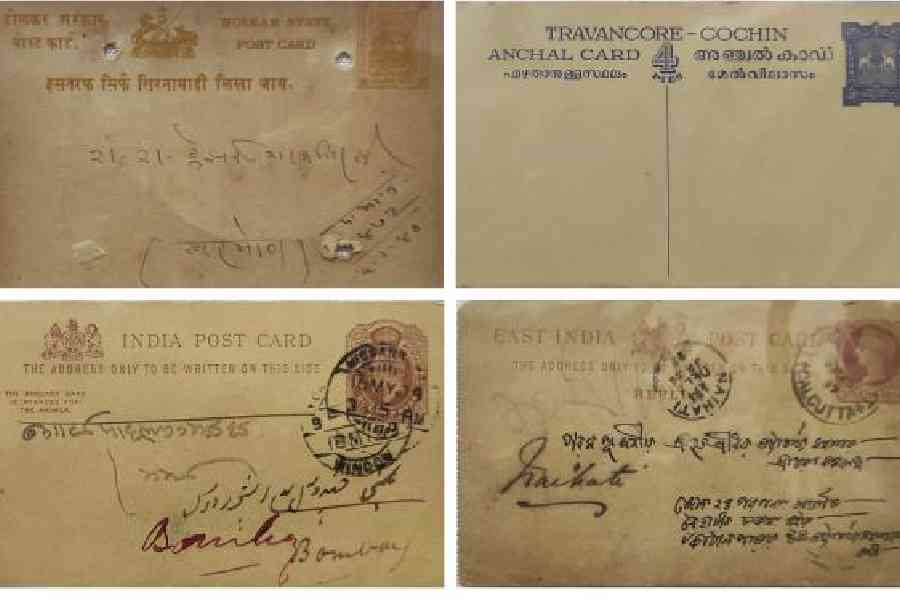Dipan Bhattacharya is a man of many passions and offbeat hobbies. He has a weakness for all things rare and antique since he was a schoolboy.
A former central government officer presently working as director of a Noida-based private company, Bhattacharya spent his childhood on the fringes of Bhatpara by River Hooghly, 50 kilometres north of Calcutta. The area has been known for its rich Sanskrit learning tradition. Bhattacharya grew up among ancient manuscripts, scrolls and sundry things in a typical Bhatta Pandit or Sanskrit scholar’s house.
While rummaging through these heirlooms, he came upon a bundle of yellowed postcards written in Bengali addressed to his great-grandfather — “the most revered Srijukto Sridhar Bhattacharya Mahashaya” — by his students. He was in high school then.
The discovered bunch were from the first postcards issued by British administrators of undivided India. “Students trained at my ancestor’s tol or traditional Sanskrit school later settled down as teachers in different parts of the country,” says Bhattacharya. They wrote to their teacher from their varied postings.
Bhattacharya fishes out one from the pile. It is from Chhapra in present-day Bihar. Even though the central-government-operated India Post still issues four types of postcards priced between 25 paise and Rs 6, their use is extremely limited. Most urban Indian millennials have never used a postcard.
The use of rectangular pieces of thick paper or open post sheets for writing and sending short and quick messages was first proposed in 1865 by a German postal official called Heinrich von Stephan. One side of the paper would have space for the recipient’s name and address and the other side would be reserved for a message. The sheet would be transmitted at the cheapest possible cost. The idea was initially summarily rejected as the authorities believed people would prefer a not-so-open format.
Four years later, however, Austria’s postal department introduced postcards. Within the first three months, three million postcards were printed and sold; soon other countries followed suit. By 1870, 75 million postcards were circulated in Britain. By 1879, postcards were introduced in India. Even though India had officially become a “jewel” in the British crown, postcards were inscribed with the “East India” mark.
The old pile had Bhattacharya intrigued. He decided to start collecting postcards. Much later he learnt that postcard collectors like himself are called deltiologists. The term originated in 1945 in the US; it took another two decades to find its way into a dictionary.
Bhattacharya decided to focus on collecting postcards issued between 1879 and 1947. The quarter anna postcards — East India Postcards — were issued till 1899.
As Bhattacharya’s job took him to postings in different parts of India, he kept looking for postcards of the first series (1879-1899). He looked in Jaipur, Deoli, Marwar, Nagaur and Jodhpur. He says, “Whenever I heard some old haveli was being demolished, I’d rush there to rummage through discarded old papers.” He had spread the word and, usually, someone or the other tipped him ahead of a demolition. Apart from Rajasthan, he collected a cache of cards in Karaikudi,
Coimbatore and Thanjavur.
His endeavour helped him trace used and written postcards from the time of the reign of Queen Victoria (end 19th century) to King George VI’s reign (1936-1952). Apart from these, he hunted out postcards issued by native Indian rulers — the Holkars of Indore, the Nizams of Hyderabad, the Scindias of Gwalior.
Most fascinating among his collection is the postcard issued by Anchal post, an early postal service started jointly by the native states of Travancore and Cochin. The word anchal derives from the Greek word angelos meaning messenger.
Bhattacharya has come across just one other deltiologist in his four-decade pursuit of postcards.
Three years ago, through social media, he got acquainted with Palash Mondal, a microbiologist working with West Bengal’s health department. Says Mondal, “I got interested in collecting postcards after my mother showed me a bunch of cards she had found in an old box in our house.”
Those cards were exchanged between members of his family 50 to 60 years ago. While going through the cards, Mondal found fascinating details of many family matters — weddings, deaths and other milestones in the lives of relatives and friends. “Bits and pieces of microhistory,” he says.
The discovery of these cards inspired him to look for more such cards and he found rare cards from pre-Independence India — including many from the princely states. He has a rare postcard used in Portuguese settlements in India — Goa, Daman, Diu, Dadra and so on — marked “India Portugueza”.
Mondal, however, stresses that his collection is not as rich as Bhattacharya’s who has been collecting cards for decades.
For both, postcards are more than any inanimate antique. Says Bhattacharya, “Each written postcard was a harbinger of either good or bad news. Small messages by common Indians reflect life and times of a bygone era not documented in any book of history.”










